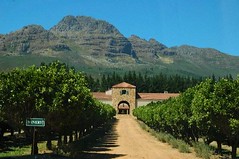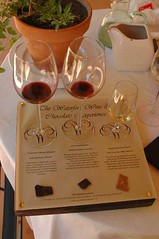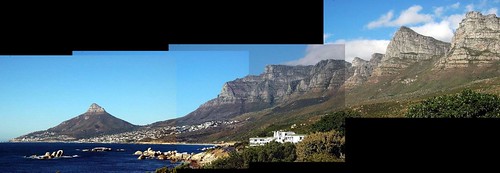Soweto
When you head from Jo'burg to the township of Soweto, the first thing you notice is the nuclear reactor. The twin towers mirror those you see when entering Capetown. The distinct difference is that the ones in Soweto are completely painted over. One of the towers is muralled with a scenes of Soweto's history. The other is an ad for First National Bank.
Erasmus points out that the towers reflect the culture of Soweto, and tells us that the mural was done for free - somebody (presumably FSB) paid for the paint, and local artists pulled together to create the massive work of art. Our first stop is just a little past the main bus stop, which is swarming with the combi-minibuses. It's around 11am, and this is the low time - so all the buses come back to the roost, I guess.
Erasmus pulls over onto a dirt patch, which looks a little like it could be a spot for a vegetable market, or a parking lot. We're to go with a local guide, a resident of Soweto, who will show us around and take us to a couple of the township homes. The three of us (Katerina, Shawn and myself) go off with our new friend, who's wearing a large floppy brilliantly red hat. It's distinct and sticks out, and I'm wondering why someone would wear a hat quite that large, and I notice that he's got a very large goitre on the side of his head. I assume the hat is to hide it somewhat. I want to ask what the affliction is, but decide not to pry.
We walk along a street that's lined with shanties. In comparison with the slums of India these are quite high end. Several have a small garden around them, and a private toilet - another shack with a pit toilet, or a septic tank. Virtually all the homes are composed of a combination of corrugated sheet-metal and assorted wood. They're painted brightly, in hues that almost make the colony attractive, and inviting. I ask our guide where all the corrugated metal comes from, and he points out the logos on a few - they're remnants of billboards, taxi-stand signs, bus shelters, and storage units. Seems like the resources are the same everywhere in the world - the industrial wastes of corporations and governments become the raw material to house the minions. Many of the houses have a fence around them, some with barbed wire. It's interesting that a house in a shanty-town, made of corrugated scrap, held together with tape and twine needs to be protected with barbed wire.
We're told that the community spirit of the township is very strong. We're taken to a shanty that we can go inside - it's occupied by an older, large lady who has 2 young girls with her. The room is no more than 20ft x 15 ft. It's smaller than my living room, but within it is a bed, a stove, a cabinet, and a washing line. There are normally 4 people that live in this space. The sheet metal is held together with strips of plywood and a few 2x4s frame the whole structure out. The's no insulation, and I comment about it. The woman and our guide confirm that the shacks get miserably hot in the summer and miserably cold in the winter. This may sound odd, but the shack still has an air of a home - like it's not a temporary structure that someone will tear down tomorrow. There's a small garden around the house, and there's space for moving around. This may sound shallow, but this is a hell of a lot better than the slums in Madras and Bombay. I remember walking through one of the slums in T-Nagar, in Madras, along the Cuoum river. There's virtually no space between the shacks there, and there's a constant swell of people. Here it seems there's some space to breathe in.
Johannesburg is home to 3.5 million people. The city houses the haves. The have-nots and those who service the haves live in Soweto. There are 5 million people living in Soweto. I ask our guide about the community effort, and whether people try to move away from the township, now that there are fewer restrictions on their travel and where they can live (outside of economically, that is). There are a handful of schools in Soweto, but none convenient for the residents. Children have to be bussed to schools, and the schools are not free. We're told that the annual fee in the local Soweto school is R80/mo. This sounds pretty reasonable to me, and he agrees. Most of the people in the township can afford it. On the question of moving out of the townships, our guide tells us that many of the residents end up living there even when they've made a fair amount of money. They like the fact of the community, and feel far safer. He says people here can be themselves. You can go to your neighbor's place and ask for food, and they'll give it to you. He says in the city, and in apartment buildings you wouldn't want to ask your neighbor because you don't want them to feel that you are too poor to have sugar or corn meal. It's an interesting take on things, and probably true. Here there's no barrier, since everyone knows why you're here.
There are a huddle of portable toilets - about 5 for each cluster of 20 shacks. They're operated by the government, and are cleaned out regularly. Our guide points out that there are a few people that have their own toilets - the septic tank or pit toilet types. He's not sure how those people got them, but it's definitely not the norm. Those that have them also seem to have their shacks on larger lots, and have much larger gardens. I see several cars in the "driveways" of the shanties. This is definitely not on par with the slums of Asia!
Several of the shanties are marked with a barcode. I assume this is a remnant of the scavenging, but then realize that coincidentally all the barcode stickers are all above the doorways. Our guide tells us that the longer term residents are on a waiting list for RDP housing - the Rehabilitation and Development Project. These shack-owners will get new digs. I ask if there's corruption in the barcode tagging - I suspect it would be quite easy to counterfeit them, or run a whole black-market operation of controlling the shacks while still getting the RDP houses. He claims that does not happen, and that everyone's honest about it. I find it hard to believe, but don't press the issue.
There's no electricity in this part of Soweto, but this is the lowest rung of the township ladder. Capetown's shantytowns all have powerlines, but that's not the case here. Our guide is unable to shed any light on this question, but says the govenment has a plan to start providing electricity to the area. When we walk back to the parking lot, where Erasmus is awaiting us, we're accosted by a few hawkers. They've got stoneware statuettes, and assorted stuff for sale. They claim it's all made in Soweto, and that any purchase we make funds the efforts of local craft workers. I'm not so sure about this, since the stuff they're selling looks exactly like the stuff I've seen at the main markets in Capetown. But who knows, maybe there really is a craft school that teaches them the same stuff. I decide not to buy anything, and the hawker thanks me anyway, and wishes me well.
We head further into Soweto, but we're now seeing the stratification in the township. Soweto is a sprawl. No building stands higher than 2 stories, except for the hospital, which is the largest hospital in Africa, and has a large cluster of at least 6-storey high buildings. As you look out across the township, it's apparent that it's not just a slum. There are the corrugated shanties, brick structures, concrete buildings, and full-on, middle-class homes. All of the black population lived here under apartheid. Nelson Mandela, Desmond Tutu, and Steve Biko all had residences here, but they had actual houses, with yards and cement fences.











